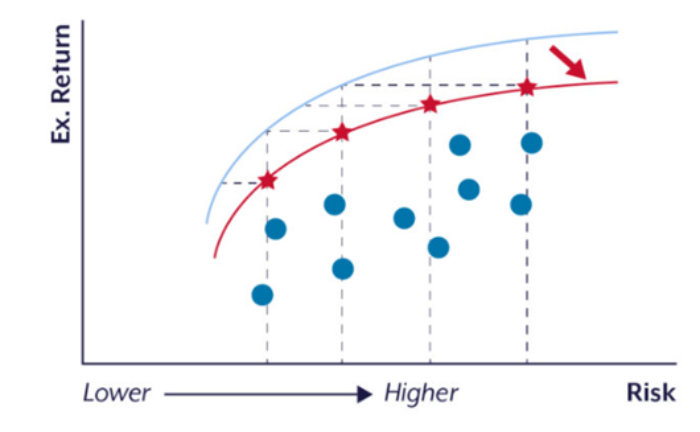Limiting how and where you invest, particularly in respect to asset classes & regions, will likely impact long-term investment outcomes.
At Charles Stanley, we focus on generating the best risk-adjusted returns within the allocated risk budget. This means maximising long-term total returns, while adhering to our risk framework and investors' tolerance for volatility. Generally speaking, if you have capacity to take more risk, you should expect to be rewarded with a better return to compensate.
Sticking to our proven investment process
A common challenge when investing is "home-country bias”, where portfolios may hold significantly more in UK assets. It’s not uncommon to see portfolios with a large home bias to their asset allocations, potentially leading them to holding five or six times as much in the UK as you would for instance on a market cap weighted basis in MSCI World (roughly 4%).
Tying yourself to the home potentially ignores better risk-adjusted returns that are available elsewhere. Investing can be challenging and uncertain at the best of times, so why try and invest with one hand tied behind your back?
It’s the reason why we are big advocates for a truly global approach, embracing a wide range of investments without geographical or asset class biases. A Centralised Investment Process is the key foundation to a strong investment portfolio – it shapes all our clients’ portfolios and is vital to achieving the best possible risk-adjusted returns, achieving our inflation targets, and accommodating our clients’ risk appetites.
Let us introduce you to our Centralised Investment Process and the investment principles that guide it through this short video:
The Strategic Asset Allocation (SAA) process occurs once a year, focusing on a 5 year time horizon representing the medium term outlook/ It is important to note that we regularly review our macro and market medium and shorter-term views on a monthly basis, using the combined expertise of our Asset Management and Research teams to drive our portfolio positioning. We are strong believers that active management is essential in a rapidly changing world.It’s believed at least 80% of portfolio returns can be attributed to asset allocation – so choosing what proportion of wealth is invested into each asset class is a crucial decision.
Read more: Why the active vs passive debate is a false dichotomy
Efficient frontier and avoiding home-country bias
The goal is to construct portfolios that sit close to the "efficient frontier," where the risk-return trade-off is optimised. A simple way of thinking about risk-adjusted returns is to look at the risk (volatility) and the return on the chart below. The objective is to enhance the portfolio return for the same level of risk or to reduce the risk for a given of return.

Ultimately, clients are left with sub-optimal outcomes; either accepting lesser returns for the same level of risk or being forced to take on additional risk to achieve the same expected returns.
There are historic reasons for this bias. Commonly cited are managers’ market knowledge and greater comfort investing in UK-listed names, the ‘home bias’ as well as client name-recognition, appreciating that clients may like to recognise the companies they are investing in. In our view, these do not justify asset allocations that negatively impact client outcomes in the long run.
If you find yourself questioning conventional biases and are contemplating the impact of a constrained asset allocation on your investment strategy, now might be the time to reconsider. Our Managed Portfolios Services provide a refreshing departure from traditional constraints, embracing a globally unconstrained approach.
Case study: global diversification in action
Consider a portfolio manager who initially had a heavy allocation to UK equities, driven by familiarity and ease of access. However, by adopting an unconstrained asset allocation approach, the manager diversified globally, incorporating US tech stocks, European industrials, and high yield bonds. This diversification reduced the portfolio's overall volatility and improved its risk-adjusted returns. During a period of market stress, while UK equities underperformed, the global portfolio's exposure to different regions and asset classes provided a buffer, demonstrating the power of a diversified, unconstrained approach.
Three key takeaways for financial advisers
- Maintain an unconstrained opportunity set
- Embrace global diversification
- Focus on delivering the best risk-adjusted returns within your risk framework
By following these principles, financial advisers can help their clients achieve their long-term investment goals with confidence.
Partnering with Charles Stanley
To discover how our Managed Portfolio Services can enhance your clients’ investment journey, reach out to us today. Let's navigate the nuances together and pave the way for a more diversified portfolio suited to you and your clients’ needs.
Nothing on this website should be construed as personal advice based on your circumstances. No news or research item is a personal recommendation to deal.
Unleashing the benefits of unconstrained asset allocation
Read this next
S&P 500 falls into correction
See more Insights